Local SEO for Franchises: 5 Strategies that Drive Results
Key Takeaways
- 80% of users who conduct local searches visit a related store within a week, highlighting the importance of optimizing Google Business Profiles and websites for local SEO to attract customers.
- 74% of in-store shoppers look for the closest store, opening times, and contact information, emphasizing the need for businesses to enhance their online presence for local visibility.
- Local SEO strategies can help franchises stand out in specific local markets, even with strong national brand recognition, by optimizing each branch to appear in search results for relevant queries.
Editor’s Note: This post was originally published in September of 2024 and has been updated for accuracy and comprehensiveness.
Consumers are looking for physical stores near them online, and they’re probably not finding you yet.
According to Google, 80% of users who conduct local searches visit a related store within a week. This means your franchise business can attract users in all your locations by optimizing your Google Business Profiles (GBP) and websites for local SEO. This lets you target consumers in those locations to increase brand awareness and conversion.
According to Think With Google,
- 74% of in-store shoppers search for the closest store near them, their opening times, and contact information.
- 59% of shoppers use Google to search, find, and learn more about something they want to buy in-store or online.
- 50% of shoppers say they discover new brands through Google.
It’s clear that many people are searching for businesses online. Local SEO for franchise strategies helps you optimize your online presence to attract users nearby. This gives you visibility for location-based queries, such as “coffee shops near me”, “moving companies in Ohio,” or “bakeries in Montrose.”
If you operate in multiple locations, you need each branch to stand out in its specific local market. Even if your franchise has strong brand recognition at the national level, local SEO is all you need to optimize other locations to appear in search results for queries related to your business.
We have helped many local companies, franchisors, and franchisees improve organic traffic and conversions, and here are some of the things that worked for us:
5 Local SEO Strategies For Franchises
When we worked with TitleMax, America’s largest title lending company, our goal was to increase awareness for their 1,000+ locations. One strategy was to improve their share of voice (SoV) for key terms related to “title loans” and “cash loans.” They also needed strategic guidance to help them recover from a manual link penalty from a previous agency.
Amongst other solutions for the franchise, we manually analyzed their inbound links to determine link quality and remove weak/manufactured links. We also analyzed data to identify high-converting keywords using our proprietary technology. The results?
- +28% Increase in Organic Traffic
- +64% increase in organic traffic value and
- +33% increase in organic leads
We’ve been doing this since 2009, and here are five local SEO for franchise strategies you can replicate for conversions if you’re a franchisee or franchisor right now:
1. Claim or Create Your Google Business Profile (GBP)
A GBP, formerly Google My Business, is a free tool for businesses to list their business and share important information about their services. This brings them closer to potential customers, shows credibility and builds trustworthiness, and also helps them show quality reviews from users who have bought their product or tried their services.
Because Google uses the information on your GBP to provide relevant local search results to users, a well-optimized profile increases your likelihood of ranking in search results.
Here’s an example of what a well-optimized profile looks like for the query “cafes in San Francisco”:

Delah Coffee even optimized the profile to show FAQs. Another user asked, “is there wifi”?, and someone responded:

These enrich the search results where you rank.
Because Google creates listings for local businesses based on the business’s information online, you can claim an existing listing in GBP. If your location doesn’t exist, you can create a new profile.
To claim your GBP, visit Google Business Profile Manager: Click on the “manage now” button, and it’ll prompt you here:
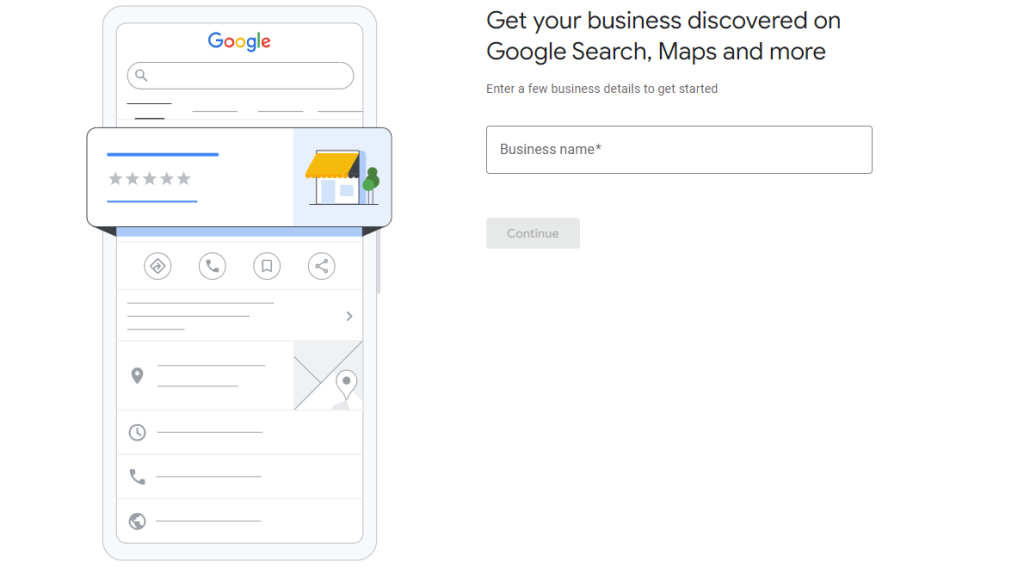
- Search for your business name or create one for your profile.
- Enter vital information, such as your business Name, Address, and Phone number (NAP)
- Write an “About” description that summarizes your products and services. This is where you should use relevant local keywords in your description and listing to align your franchise business with what customers are searching for.
For example, if you’re a franchise for Chick-fil-A, some of the keywords you can rank for include:
- Chick-fil-A breakfast
- Best fast food in [city name]
- Chick-fil-A menu
- Chick-fil-A near me
Ranking for these keywords will definitely help you rank higher on search results for location-specific searches.
Here’s an example using the keyword “McDonald’s menu” in Maasdijk, Netherlands. If this franchisee’s GBP and website aren’t optimized for the keywords, I won’t find them on the SERPs. And this means their competitors will take their spot— which means they’ll lose some valuable traffic and conversions.
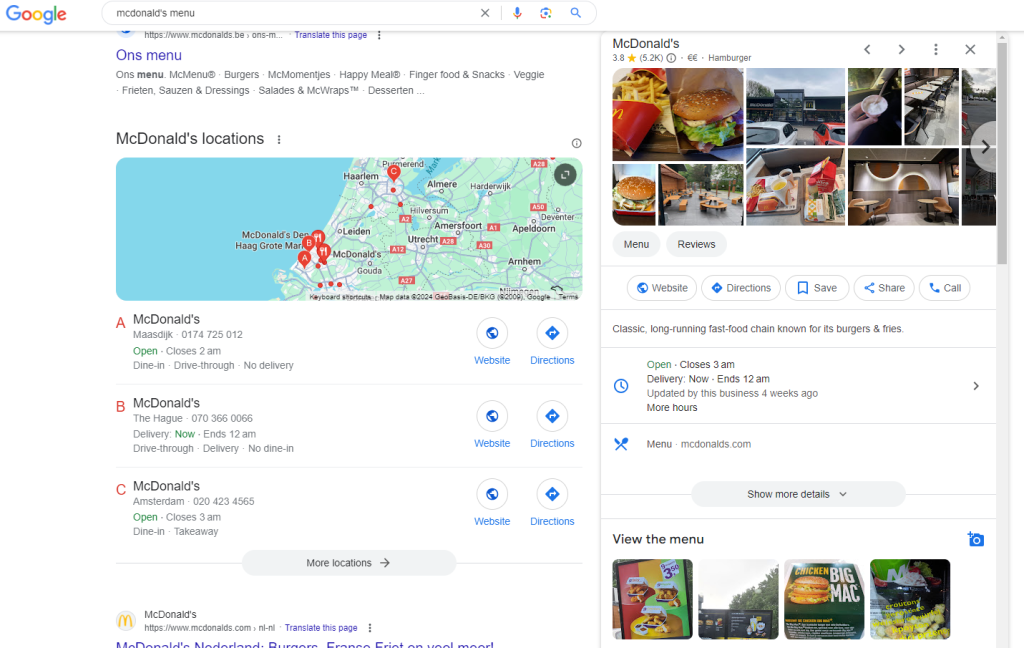
- Add other necessary details, such as updates on a “Tuesday Mega Discount,” a website link, opening hours, and the categories your business falls into.
An easy way to know that is to search for keywords other businesses like yours are using. For example, you can install the GMB Everywhere extension to find the categories your competitors are ranking for. See “GMB Cat” below for an example for the keywords “moving company in Ohio”:

Including these categories can increase your chances of ranking on search results.
- Include pictures of your product, store or service in action to show consumers what to expect from your business. You can add as many pictures as you like— this coffee shop has over 1000 pictures to display.

- Encourage and ask customers to leave reviews on your profile, website or other review platforms. Respond to each review, whether positive or negative, to build customer trust and encourage them to come again.
2. Create Location Specific Pages If You Have Several Locations
Separate landing pages can help each of your franchise locations better approach content to suit the intent and needs of their audiences. Different location pages help them rank better in local search results and attract clicks from interested consumers.
Infuse location-based keywords in your page title, headers, address ,and in other elements of your landing page. If you run a coffee shop franchisee in Brooklyn, NY, a location-based keyword might be “Chick-fil-A coffee shop in Brooklyn”.
However, before you can optimize for a keyword, you need to choose keywords that are likely to give you exposure and increase your chances of conversion. To know what keywords to rank for, use tools like Ahrefs, Moz, SEMRus,h or Google Keyword Planner. You can even use free tools like Answer the Public. Here’s how to get started with keyword research via SEMrush:
- Head to SEMRush Keyword Magic Tool
- Enter a broad keyword related to your business. I’ll use “coffee shop in Houston”.
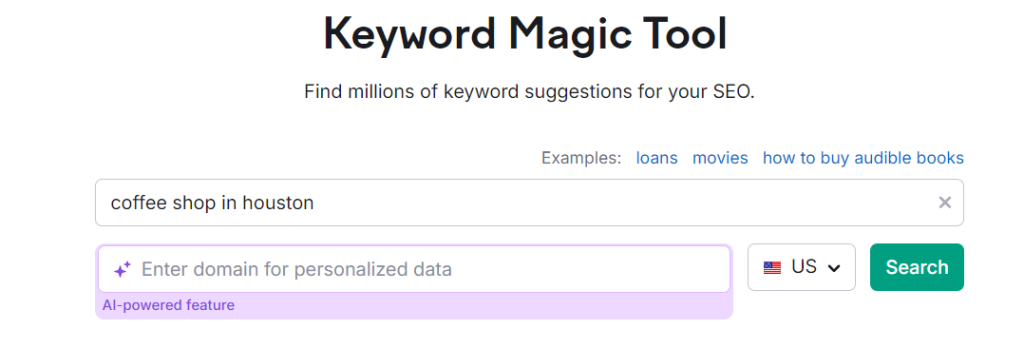
- SEMRush will provide a list of popular search terms that include your broad keyword and location.
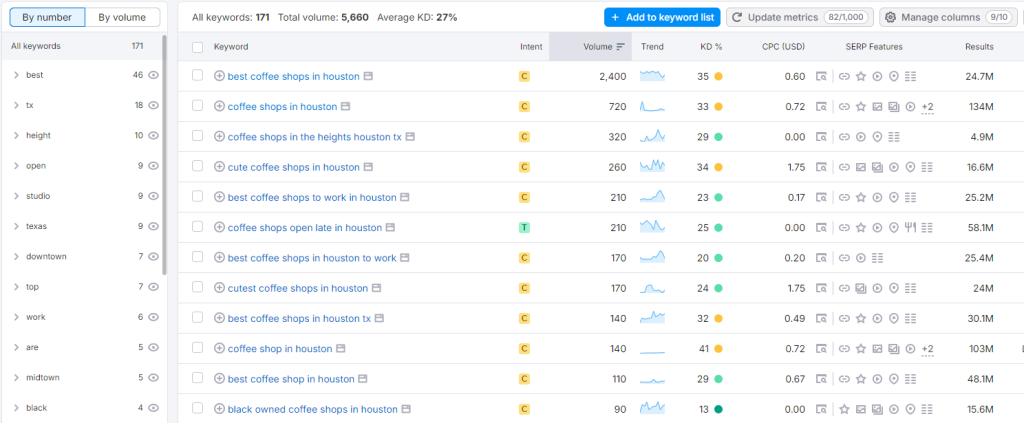
You can also sprinkle keywords related to your seed keyword over your landing page. For instance, these are the related keywords for “coffee shops in Houston” and you can filter them in your content while writing.
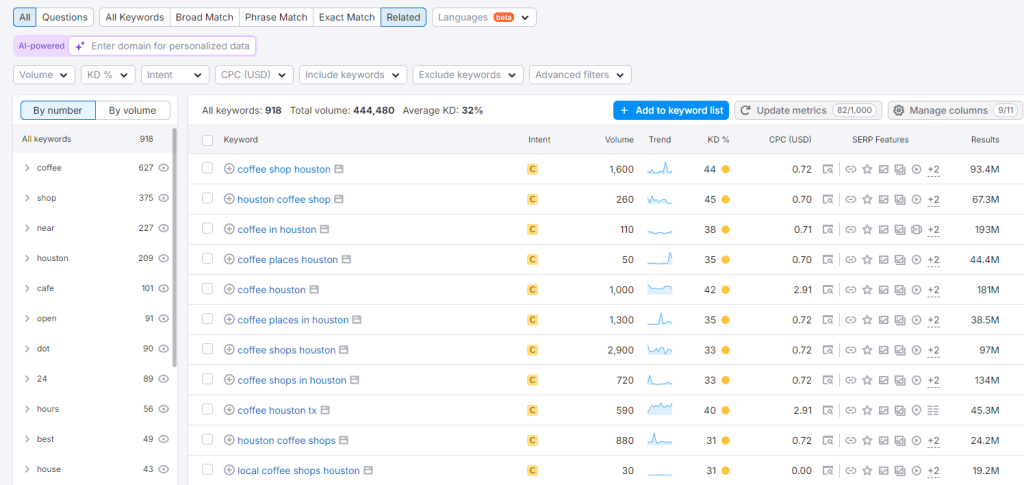
Using any of these keywords, you can rank better on search engines and attract foot traffic to your business.
Optimized location pages also need high-quality images. High-quality images of your products, services, or storefront give visiting consumers a visual representation of what you offer.
Google values rich media, so including images and incorporating them into your location pages is a local SEO strategy for franchises to increase interest in your business. It also builds authenticity, which can encourage customers to visit the store, make a purchase, or book a service.
3. Create EEAT Content
EEAT stands for Experience, Expertise, Authoritativeness, and Trustworthiness. Google uses EEAT as a search quality evaluator to assess the quality of content or a page.
EEAT in itself is not a direct ranking factor. It only helps Google determine whether a page is helpful and reliable to users or not. Google will favor content with strong EEAT qualities, which would improve your ranking on SERPs.
According to Google:
Your content (if you’re running a blog) must pass these four criteria to be considered helpful or informative content. You should create content that addresses the needs of your target audience, and these four criteria are important in deciding whether you’ll rank or not.
- Experience
Google announced the addition of an E(experience), to the formerly known E-A-T in December 2022, by saying:
“There are some situations where really what you value most is content produced by someone who has first-hand, life experience on the topic at hand.” This means if you’re creating content about recipes for a particular type of pizza because you’re a Domino’s Pizza franchisee, you must be an actual chef who is trusted.
To Google, Experience shows that you know what you’re writing about.
Your content should provide insights into the queries people are searching online, so as to show that you know what you’re writing about.
- Expertise
Expertise refers to your skills and knowledge about a topic.
An example of showing expertise is by creating content authored or reviewed by industry experts.
This post by Investopedia on alimony has been reviewed by an expert. It shows Google and readers that the content was created by people who understood finance and law, and can give clear explanations to users who searched for queries related to Alimony.

Users will trust your content more when it is created by experts, and Google may rank the page as a reliable page.
- Authoritativeness
Authoritativeness is a website’s reputation as a reliable source of information. You should intentionally make efforts to make your website a well-established, go-to source for queries around your businesses. This is why McDonald’s, Walmart, and other franchises have a blog.
For example, users would visit the Financial Times for finance news, advice, and how-tos, WebMD for health information, and ESPN for sports news.
You can also increase the authority score of your website by investing time in backlink building.
Backlinks are links from one domain (website) to another domain (your website). They’re like credibility stamps from other authority domains linking back to your site to show that your website is relevant to search engines. The more quality backlinks you have, the higher your website authority (which means the more you’ll rank online for your keywords).
Some of the ways you can build quality links include:
- Writing quality content that other sites want to link back to. For instance, Investopedia is an authoritative site with several backlinks because the website publishes informative and relevant finance content.
- Writing articles for reputable blogs in your industry, with a link back to your site. This is also known as guest blogging. For context, you can get published in a local media newspaper and an online magazine, and this will give you some exposure.
- Try networking and building relationships with industry influencers and other website owners to encourage them to link to your content.
Learn about how to build backlinks here.
- Trustworthiness
Trustworthiness refers to the honesty, accuracy, and reliability of content on your website. Your website must have:
- A strong security (HTTPS, not HTTP)
- Clear contact information
- A detailed and trusted About Page
- Testimonials and reviews.
EEAT content should address the needs of users visiting your page. It should answer their questions, offer solutions to problems, and offer advice on how to solve them.
One of the ways to go about this is to develop a good content strategy. Franchises that want to produce EEAT content should:
- Define what they want to achieve with their content (increase website visibility, conversion, sales?)
- Understand your target audience and their needs (informational content, content about your processes, reviews, so they can trust you, or a mix of everything?)
- Have a content calendar to plan out a content creation schedule. This will help you create a regular schedule for writing and publishing high-quality content.
- Establish KPIs to measure your strategy’s effectiveness.
We wrote more on how you can build a winning content strategy here.
4. Be Visible on Review Sites like Yelp or G2
Review sites are an easy way to convert customers. Users rely on review sites to know if they can trust a company by double-checking them here, and you may lose potential customers if you’re not listed on these sites.
Review sites like Yelp, G2, TripAdvisor, and Facebook Business Page usually appear in the top search results for local queries. If your franchise locations are listed on these platforms, you’ll have more visibility to those looking for a service/product like yours in the area.

This is what a listing on Yelp looks like:
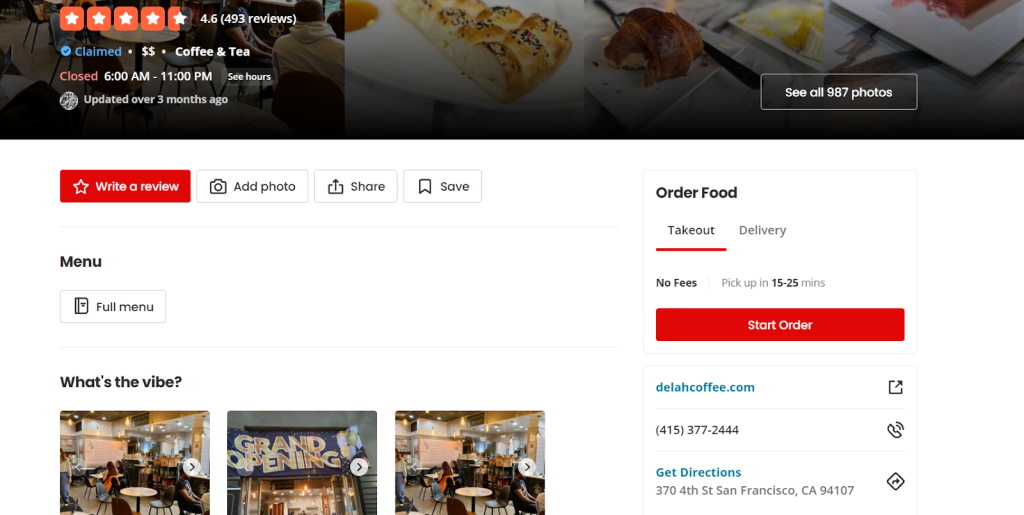
Google ranks local search results based on three factors:
- relevance,
- distance, and
- prominence.
It also ranks businesses based on the number and quality of reviews from prominent sites like Yelp, Trip Advisor, and Google Reviews.
According to Google, “review counts and ratings contribute to a business’s prominence.” This means that having more reviews and positive ratings will improve your franchise’s local ranking.
One of the ways to increase the value of your business profile on review sites is to encourage customers to leave a review after trying your product or using your service. This way, customers can write reviews on what they liked about a service or product.
For example, customers loved the milk cake and latte in this coffee shop in San Francisco, and local customers looking to get that menu are more encouraged to try them out:

Encourage satisfied customers to write reviews on these platforms. You can ask them in person at the point of sale or follow up through email, especially if they booked your service online.
Here’s an example of a company asking consumers to leave a review through email:

Another way is to create a page that shows your existing review and a CTA that prompts readers to “leave a review” on another page. Here’s an example from this company:
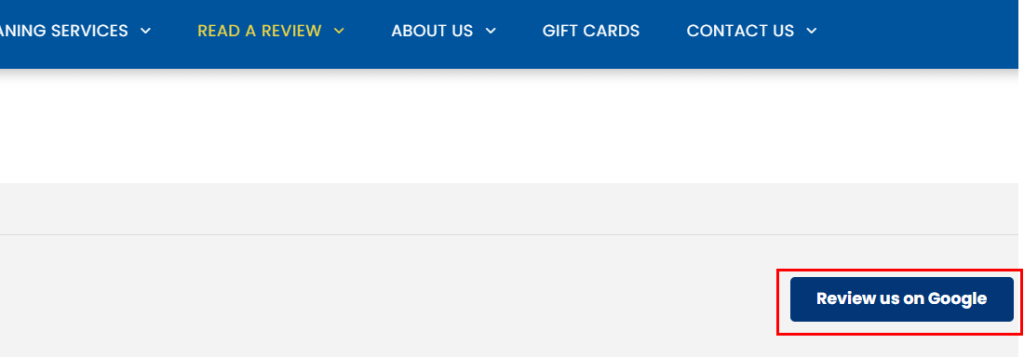
The easier you make it for customers to leave a review, the more likely they are to write the review.
5. Improve Technical SEO
Technical SEO is the process of optimizing your website’s technical aspects to improve its visibility for users and search engines. It’s the “backend stuff” that improves your visibility on Google.
One way to improve technical SEO is to make your website crawlable. This makes it easy for search engines to access, crawl, and index pages on your website. Google ranks sites that its crawlers can discover and understand.
How do you make your site crawlable?
- Use clear and descriptive URL
URLs are virtual addresses that connect users to your page. Use URLs that users and search engines can easily read. Long and complex URLs are tedious and push your content to the back.
Here’s an example of what a clear URL looks like:

This shows that the URL clearly points to new mens shoes from Nike.
- Avoid duplicate content
Your franchise websites are selling the same products and services. This means they’re probably using similar keywords (except if they operate in different locations). However, this isn’t a problem until you use the same content (or duplicate content) for multiple pages on your website.
Duplicate content is any content (same or similar) that appears twice on your website either as the corporate franchise website or as the franchisee’s website.
Here’s an example I found online, thanks to Ahrefs. It’s a page from Calton Nutrition protein powder: https://caltonnutrition.com/tag/protein-powder/
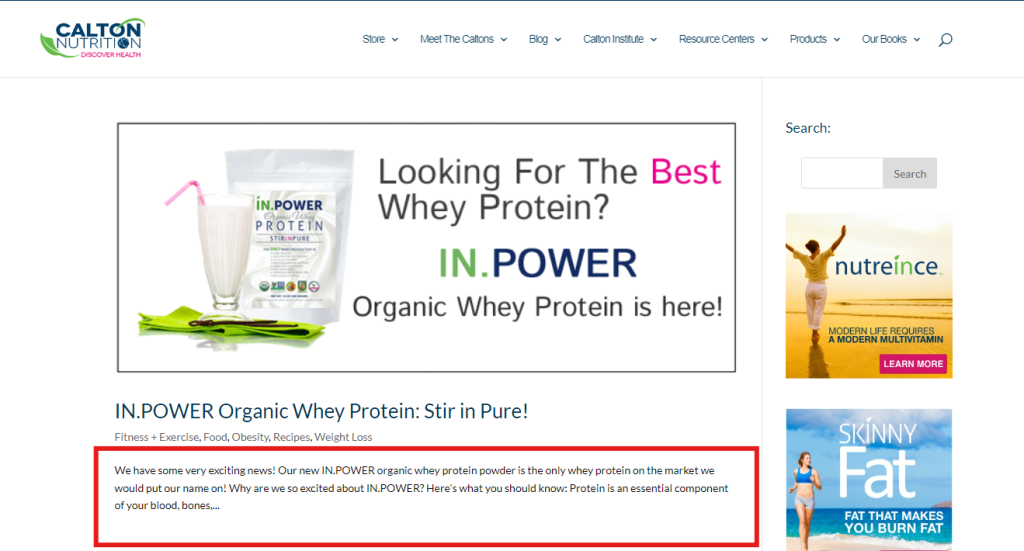
This is another page that mentions whey in the URL: https://caltonnutrition.com/tag/whey/
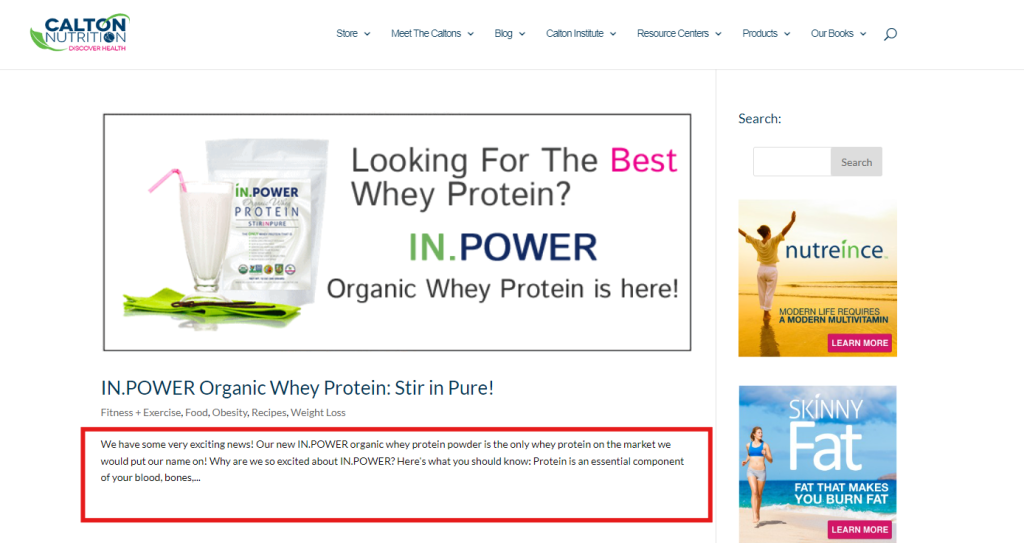
As you can see, both URLs are different. The first one mentions protein powder, and the second mentions whey. The URLs point to different pages and are a classic example of duplicate content. This can hurt your SEO performance because Google doesn’t know which URL to rank on Google for the keywords you optimized the content for.
When Googlebot discovers duplicate content on your site, it ranks the one it believes is best and pushes the other one out of SERPs. This may affect you because your idea of the best content for the keyword may differ from Googlebot’s. Google warns:
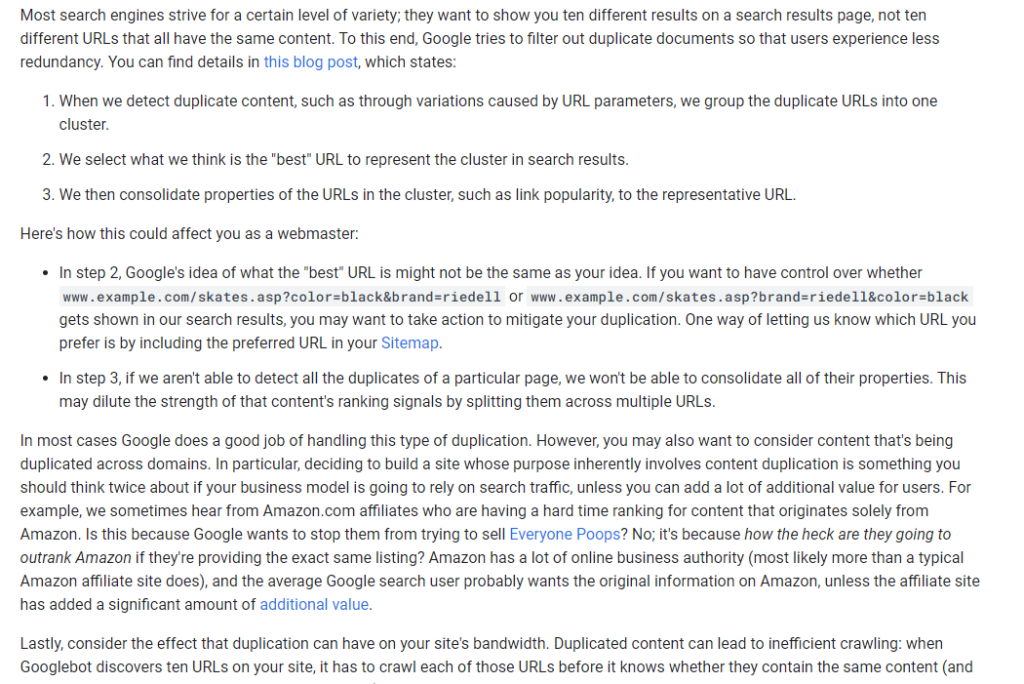
- Optimize for Mobile:
Another way to improve technical SEO is to optimize your website for mobile use. 91% of users shop online with their mobile phones, and more than half of website traffic comes from mobile users.
Optimizing your website makes it easier for potential customers to navigate it. Mobile-friendliness is also a significant ranking factor for search engines. For example, Google runs your website through a mobile-friendly test to determine whether it’s optimized for mobile users.
You can check your website’s mobile-friendliness with the Google Mobile-Friendly Test.
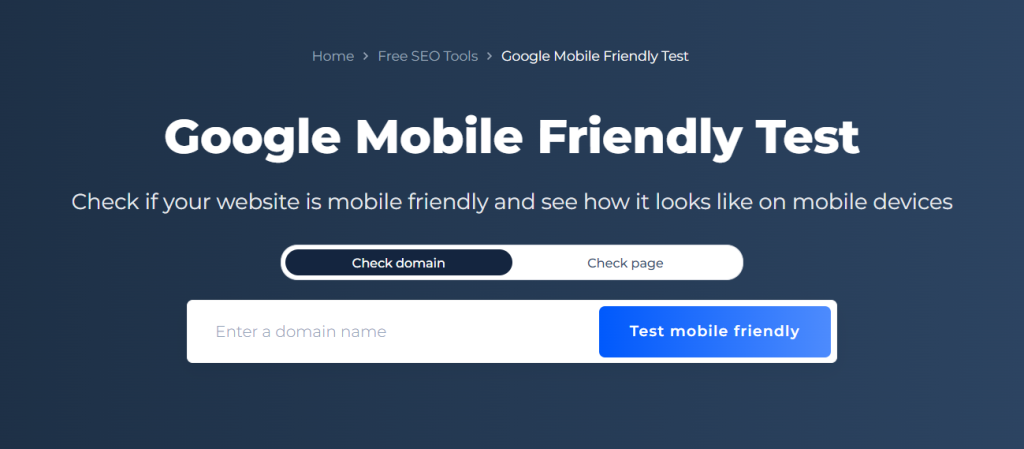
Type in your domain or page URL. I used a URL from one of our pages.

It runs your report within minutes and shows your mobile optimization and page speed percentage.
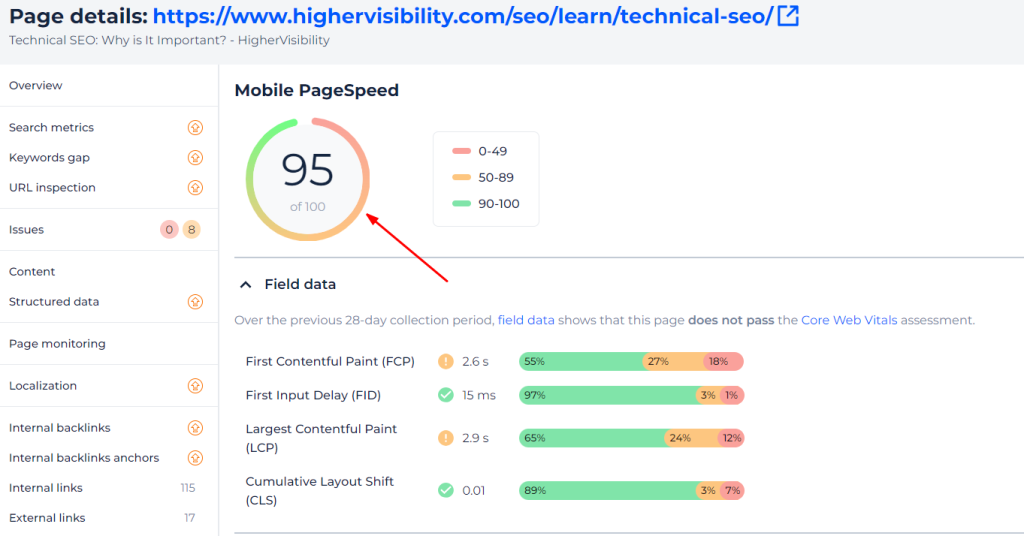
Other important elements of technical SEO include:
- Using schema markup to help search engines understand your content.
- XML sitemaps to guide search engines in indexing your site.
- Page speed
- HTTPS security
- Fixing broken links
We discussed these elements at length in our article on technical SEO and its importance for website ranking. We also wrote on how to know if your SEO is working.
Conclusion
Local users are more likely to shop at stores in their neighborhood rather than those miles away. This means you already have a client layout, especially if you’re in a strategic location. All you need to do is optimize your business using local SEO for franchise strategies and be positioned to attract users.
Sometimes, a website may rank but still get low conversion rates. This happens mainly because you optimize your website for high-traffic keywords and don’t focus on keywords with high conversion rates. Using our strategies here can help improve your local SEO strategies and convert visitors to customers. However, we understand that this may be a bit difficult, especially if you’re not used to the technical part of SEO. We have a team of SEO experts that can improve your website’s visibility to turn those curious visitors into long-term customers. Hit this link to get in touch with us, and you can learn more about our franchise SEO services here.
